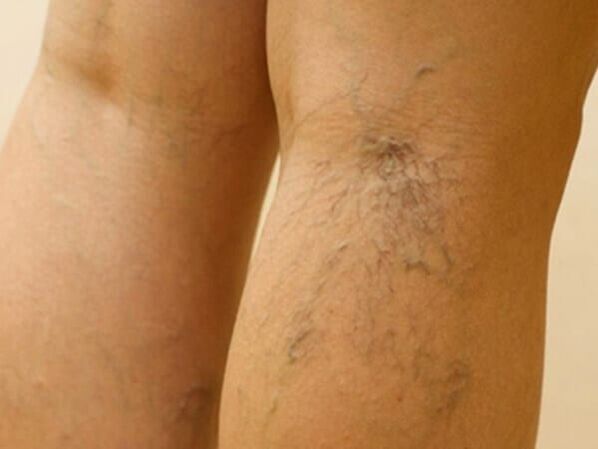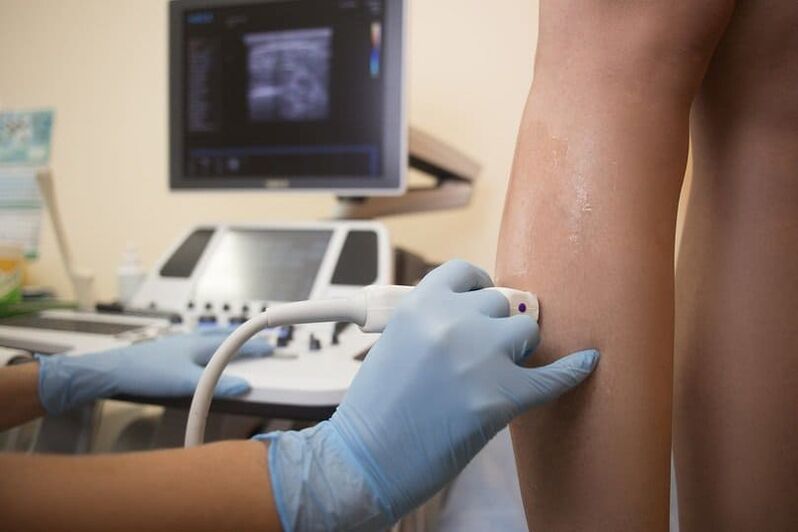Varicose veins are a disease of veins that dilate, lengthen, and form nodules and thin vein walls. It can affect various blood vessels, but it occurs most often in the lower extremities.
In advanced cases, it can lead to malnutrition in the affected area, developing ulcers, eczema, and even necrosis and gangrene. Therefore, it is very important to make a correct diagnosis and start treatment in a timely manner.
How is varicosity formed?
The exact cause of the disease is unknown. But the mechanism by which varicose veins start is well known.
The venous network of the lower extremities is represented by deep and peripheral veins and the communicating (perforated) vessels that connect them. Normally, blood flows to the heart through veins, from peripheral vessels to deep vessels.
This is done due to the work of the muscle pump (contraction of the muscles of the lower extremities), the tension of the blood vessel walls, and the valves of the veins. The circulatory system is regulated by vasomotor centers in the brain.
But if a violation occurs in at least one of the links, reverse blood flow occurs. At the same time, peripheral blood vessels dilate and the valves stop closing, resulting in more blood stasis in the peripheral circulation.
Under blood pressure, the walls of the veins continue to dilate, causing the blood vessels to elongate and form knots. Valve insufficiency increases, edema develops.
Compression of peripheral nerves sends signals to the brain that there is a need to increase tension in the walls of blood vessels. This increases blood pressure in the deep vessels, forcing blood out of the deep vessels and into the peripheral vessels, causing them to expand further. A vicious circle is closing.
what causes varicose veins
The real cause of varicose veins is not known. But many factors and physiological conditions have been shown to contribute to its development.
like:
- Pregnancy (difficulty in blood circulation to the lower extremities due to the compression of the abdominal vena cava by the pregnant uterus);
- obesity;
- a sedentary lifestyle;
- Genetic susceptibility (weak valves or reduced tension in the vessel wall);
- Violation of hormonal balance (leading to increased blood viscosity and difficulty in outflow);
- Post-operative condition (due to increased blood clotting and bed rest);
- Occupations related to maintaining an upright posture (on the legs) for long periods of time.
If one of these conditions occurs, it is necessary to take precautions to prevent the development of varicose veins. Especially if there are already any clinical manifestations.
Symptoms of varicose veins
The first signs of varicose veins are:
- lower extremity pain and heaviness;
- swelling of the legs at night;
- spider veins appear on the skin;
- tight veins are visible under the skin;
- Burning and itching in the affected area;
- Muscle spasms in the lower extremities, especially at night.
The pain of varicose veins comes on and gets worse at the end of the day. They have an explosive, painful personality. At the onset of the disease, they disappear after rest, so the patient does not see a doctor for a long time.
On examination, edema, leg cramps, telangiectasias, and tense venous trunks are found on palpation, often painful. The skin and varicose veins on the legs can be seen in the photo.

In severe decompensation, weakness, dizziness, and fainting may occur. At the same time, significant nutritional disorders appear on the skin, with ulcers, dermatitis and eczema. See your doctor promptly to prevent serious symptoms of varicose veins.
Types of varicose veins
Varicose veins are of the following types:
- Varicose veins of the lower extremities (the most common variant);
- Varicose veins of the upper extremities;
- Small pelvic varices (including uterine varices);
- Varicose veins of internal organs (esophagus, stomach, intestines, etc. );
- Varicose veins on the face.
The most studied type is lower extremity varicose veins. It happens most often and is usually what he means when he talks about the disease. Most patients do not know if internal varicose veins are present and how they manifest until they encounter them.
Stages of development of varicose veins:
| disease stage | clinical manifestations |
|---|---|
| Stage 1 | No symptoms, varicose veins detected only on instrumentation |
| Stage 2 | Heavy legs syndrome, transient edema, spider veins on the skin |
| Stage 3 | Persistent edema, skin pigmentation disorders, densely tense veins and lymph nodes are visible, nutritional disorders in the form of eczema |
| Stage 4 | trophic ulcer, dermatitis, necrosis |
The smaller the stage, the easier the treatment and the better the prognosis for recovery.
Diagnosis of varicose veins
To make a diagnosis, in addition to examining data and characteristic complaints, laboratory and instrumental examination of the patient is required.
laboratory diagnosis
What tests are needed for varicose veins:
- Complete blood count using extended formula.
- Coagulation test:
- clotting time;
- prothrombin test;
- Determination of antithrombin III, protein S and C;
- determination of homocysteine levels;
- APTT index research;
- Determine the level of D-dimmer;
- Determination of von Willebrand factor activity, etc.
- Biochemistry of blood.
- Hormone analysis.
- General urinalysis.
- function test.
Determining the status of the blood coagulation system is decisive for the selection of therapeutic strategies and prognosis of disease progression.
Instrumental diagnosis of varicose veins
Instrumental research methods used:
- Ultrasound of veins;
- Doppler imaging;
- Duplex venous ultrasound scan (combined ultrasound and Doppler contrast);
- Angiography;
- Photoplethysmography (PPG);
- venography;
- Venous Occlusion Plethysmography (VOP).

With these types of studies, the thickness of the blood vessel walls is measured, the condition of the venous valves, whether there is reverse blood flow in the veins, etc. With the help of instrumental methods, not only a correct diagnosis can be made, but also the stage of the disease can be accurately determined.
Treat varicose veins
Combating varicose veins includes both pharmacological (conservative and surgical) and non-pharmacological approaches. The choice of specific options depends on the stage of the disease and the degree of its external manifestations.
Conservative treatment of varicose veins
Treatment of this disorder involves surgeons and phlebologists. At the first signs of the disease, you need to contact a doctor with these specialties. They will confirm the diagnosis and prescribe how to treat varicose veins in this situation.
In conservative treatment, the following groups of drugs are used:
- Antiplatelet agents for blood thinning and thromboprophylaxis;
- Direct and indirect acting anticoagulants that improve the rheological properties of the blood and prevent it from thickening;
- phlebotonics strengthens the walls of blood vessels, a herbal preparation of horse chestnut extract;
- Anti-inflammatory drugs are used if necessary (in the presence of inflammation of the vessel wall or surrounding tissue).
Most of these drugs are available for oral administration (tablets and capsules) and topical (in the form of ointments, gels, creams). Your doctor will tell you which form is best for the patient based on the specific clinical situation.
Surgical treatment of varicose veins
Conservative therapy will help to completely cure the disease only in the early stages. Surgical treatment of varicose veins is necessary in advanced cases and in cases of decompensated symptoms.
Surgical intervention may include excision of the entire vein or only the affected area through incisions along the blood vessel or in the inguinal fold and popliteal fossa (depending on the specific vein and its location). But whenever possible, doctors try to perform less-invasive procedures that clot the affected blood vessel, causing it to become completely blocked.
Alternate Action Options:
- sclerotherapy (introduction of special sclerosing drugs into the lumen of blood vessels through a catheter, these drugs cause the blood vessels to adhere tightly and are subsequently replaced with connective tissue);
- Intravascular laser coagulation (coagulation of the lumen of blood vessels with laser pulses);
- radiofrequency coagulation (bonding of vein walls due to exposure to high-frequency current pulses);
- Veneectomy (removal of a vein or part of it through several punctures in the skin).
When coagulation is performed in a different way, the result is the same - after gluing the vessel wall, its lumen will gradually fill with connective tissue and develop a complete blockage. In this case, the movement of blood will continue through healthy vessels, bypassing clotted vessels. A scenario for doing this can be seen in the video in this article.
The surgical approach has an indisputable advantage - the likelihood of postoperative recurrence is very low. In terms of risk-to-efficacy ratios, less trauma is better. But their prices at the clinic are quite high.
Nonpharmacological treatment of varicose veins
It is very possible to strengthen the walls of varicose veins without the use of pills.
From non-drug means for this use:
- Therapeutic exercises (stimulation of muscle pumps);
- Compression stockings and elastic bandages (pressure in the lower extremities stimulates blood to drain from the blood vessels, normalizes the function of the venous valves and strengthens the walls of the blood vessels).
Compression stockings are recommended for all at-risk individuals, especially:
- pregnant woman;
- work standing up all day;
- all persons who have travelled long distances on an aircraft;
- patients taking drugs that promote blood clotting;
- People with sedentary lifestyles.
prevent varicose veins
Preventing varicose veins is best started before it appears. In addition, the recommended measures will help prevent other cardiovascular diseases.
Precautionary Statements:
- give up all bad habits;
- Carefully monitor your diet (excluding fatty, fried, smoked, sweets);
- strict weight control;
- Live an active lifestyle (more walking, running, cycling, rollerblading, etc. );
- Wear comfortable small heels;
- daily contrast showers;
- At the end of the day, lift your legs and rest for 15 minutes.
These measures will also help identify varicose veins - to prevent further progression of the disease and the development of complications.
Many people are interested in whether varicose vein exercises can be done. The attending physician will give the exact answer to this question, but in most cases, you can engage in sports, excluding heavy-duty sports associated with power loads.
Varicose veins are a common disease. Women are 4 times more likely to develop the disease than men, and this is related to hormonal background, pregnancy and the specificity of a large number of women's occupations that involve standing all workdays.
But timely prevention will help prevent varicose veins in both men and women. The main thing is not to ignore the advice of the doctor and not to forget the regularity of preventive measures.

















